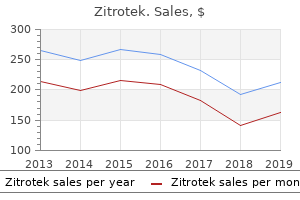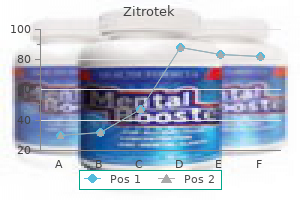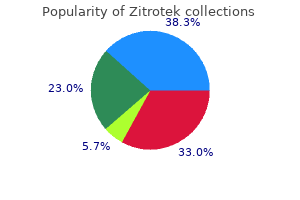

 5100 Springfield St. Suite 108, Dayton, Ohio 45431-1274
5100 Springfield St. Suite 108, Dayton, Ohio 45431-1274Zitrotek
"Generic zitrotek 500 mg, antimicrobial news".
By: J. Cole, M.S., Ph.D.
Deputy Director, Ohio University Heritage College of Osteopathic Medicine
Any of the three ventricular fascicles may be affected (right bundle infection preventionist salary order genuine zitrotek on-line, left anterior fascicle virus finder buy 250 mg zitrotek amex, or left posterior fascicle) infection kidney failure 250mg zitrotek mastercard. Impaired conduction in the anterior fascicle causes the posterior aspect of the left ventricle to be activated irst, followed by spread through the left ventricular myocardium in an upward and leftward direction. Left posterior fascicular block (hemiblock) is due to a block in the posterior fascicle of the left bundle, which causes the anterior left ventricle to be activated irst, followed by spread in a downward and rightward direction. Slowed or obstructed conduction may occur simultaneously in more than one bundle or fascicle, leading to the terms bifascicular block and trifascicular block. For example, a right bundle branch block occurring in conjunction with a left posterior hemiblock is called a bilateral or bifascicular block. Complete trifascicular block would make it impossible for a supraventricular depolarization to activate the ventricles and would be a third-degree or complete heart block. Dysrhythmias are generally treated if they produce signiicant symptoms or are expected to progress to a more serious level. A number of antidysrhythmic drugs have proved effective in managing many dysrhythmias; however, most have also been shown to cause dysrhythmias (prodysrhythmic). The major electrophysiologic classes of antidysrhythmic (antiarrhythmic) compounds are summarized in Table 19-4. Treatment may also include measures to improve cardiac output, including pacemakers and drugs to improve contractility and blood pressure. Dysrhythmias causing severely reduced cardiac output, such as severe bradycardia, asystole, ventricular tachycardia, and ventricular ibrillation, require cardiopulmonary resuscitation until an effective cardiac rhythm is established. Ablation procedures may be effective in eliminating a focus of dysrhythmia generation if one can be identiied. An electrophysiologic study is done to evoke and analyze the dysrhythmia, followed by interruption (ablation) of the area generating it. Ablation is accomplished with highfrequency radio waves (radioablation) or by surgical excision. The electrophysiologic study requires insertion of electrodes directly into the heart by way of a venous or arterial catheter. The electrodes are used to record activity in speciic locations and to deliver electric shocks to initiate or terminate an abnormal rhythm. Those at high risk may beneit from insertion of implantable deibrillators that detect lethal rhythms and apply an electric shock to convert the rhythm. Decreased cardiac output to the tissues results in decreased renal blood low, luid retention, activity intolerance, and mental fatigue. Backward effects are due to congestion of blood behind the ineffectively pumping ventricle. With left-sided heart failure, the congestion is located in the lungs and produces a number of signs and symptoms, including dyspnea, orthopnea, hypoxemia, crackles, and frank pulmonary edema. Isolated right-sided heart failure causes congestion in the systemic venous system leading to congestion and dysfunction of the liver, spleen, and kidney, as well as peripheral subcutaneous edema and distended neck veins. Those with low ejection fraction are commonly described as having systolic failure. Three major compensatory mechanisms operate to maintain cardiac output in the failing heart: (1) sympathetic activation, (2) increased preload, and (3) cardiac muscle cell hypertrophy.

However infection treatment generic 500mg zitrotek mastercard, the combined action of mast cell and T cell mediators recruits other T cells and macrophages to the site infection zone tape 100mg zitrotek with mastercard. Alterations in Immune Function 207 Cutaneous Basophil Hypersensitivity Cutaneous basophil is the most rapid type of delayed hypersensitivity reaction oral antibiotics for acne over the counter purchase genuine zitrotek on line. Soluble antigen that has been injected intradermally or antigens introduced into the dermis trigger T-cell activation and subsequent release of cytokines and activation of basophils, which iniltrate the area. An example of this type of hypersensitivity is skin graft reactions and rejection. It is an immune or inlammatory response to a wide variety of plant oils, chemicals, ointments, clothing, cosmetics, dyes, and adhesives. The reaction is slow because the skin-penetrating antigen is very small and in an incomplete form. The hapten must irst penetrate the epidermis, where it links with a normal body protein, called a carrier. Only after the hapten combines with the carrier is it a complete antigen-often called a hapten conjugate. The complete antigen is processed by dermal dendritic cells located in the suprabasal epidermis. The dermal dendritic cells move to the local lymph channel, where they migrate to the regional lymph node. The presentation of antigen to T cells causes the lymphokine cascade of vasoactive and cytoactive substances. After primary exposure or immunization, a cellular reaction takes place at each subsequent exposure site. For example, a person with contact dermatitis to nickel will react when exposed to a variety of nickel alloys, including the metal in earrings, zippers, snaps, and belt buckles. Skin symptoms resulting from contact dermatitis include redness (erythema), edema, pruritus, and blisters. People with sensitivities may also experience respiratory symptoms if exposed to aerosolized hapten. This situation could occur when a person is downwind from burning poison ivy or burning tires. Patch testing for diagnosis of contact hypersensitivity is indicated when symptoms persist despite avoidance of the suspected agent and with appropriate use of topical therapy. There are several types of patch tests including open and closed testing used by dermatologists and allergists. In open patch testing, the suspected allergen is applied twice daily to the upper arm and left uncovered for 2 days. In closed patch tests, the suspected allergen is applied to the skin away from the original site of eruption and is covered with an adhesive bandage. A 1+ positive patch test response involves erythema of the entire area of exposure. The person experiences erythema, induration, and inlammation at the site of the intradermal injection. Because the amount injected is so small, the reaction disappears when the antigen has degraded. Epithelioid cells originate from macrophages and are large, lat cells with a large amount of endoplasmic reticulum. Gradually, ibroblastic activity and increased collagen synthesis cause the granuloma to become ibrotic with scar formation. Often, central necrosis occurs within the granuloma and is called caseous or cheesy necrosis. Granulomatous diseases and the pathogens associated with them are listed in Table 10-6.
Cheap 250 mg zitrotek visa. First-line H. pylori eradication therapies in countries with high and low clarithromycin resistance.

But again virus 68 michigan order zitrotek 250mg without a prescription, all these symptoms are also seen with other conditions involving the urinary tract antibiotics that start with r order line zitrotek. In most cases antibiotics origin cheap zitrotek 100mg, diagnostic evaluation for bladder cancer is initiated because of the development of one or more of the previously listed clinical manifestations. A thorough history may reveal risk factors for bladder cancer, or physical examination and diagnostic testing may indicate another etiology. The recommended diagnostic test for suspected bladder cancer is cystoscopy, with biopsy of any questionable tissue and washings of free cells for cytologic examination. The sensitivity and speciicity of available tumor markers varies widely; at this time, no tumor marker is reliable enough to replace cystoscopy. The stage of the malignancy is an important contributor to treatment decisions, and also aids in the determination of prognosis. All of this information is used to guide the selection of the speciic treatment approach. The primary options are surgery, radiation therapy, chemotherapy, and immunotherapy. Chemotherapy or radiation therapy may be performed preoperatively to reduce tumor size and improve survival. Urine is drained from the reservoir often through a stoma created through the abdominal wall; however, substitute bladder reservoir (neobladder) procedures involve connecting the urethra to the reservoir, allowing the patient to void normally. In cases where the tumor is large or there are multiple bladder tumors, a radical cystectomy is performed, in which the bladder and surrounding nodes are removed; in men the prostate gland is also removed, and in women the uterus, ovaries, fallopian tubes, and part of the vagina are also often removed. External beam radiation therapy may be an acceptable alternative for patients who are not suficiently strong for radical surgical procedures. The normal defense mechanisms of the urinary tract are presented in detail in Chapter 27 with the discussion of pyelonephritis (infection of the kidney). By the time infection reaches the kidneys, the bladder and urethra are already infected. Inlammation of the urethra may lead to pain, burning, and urinary incontinence, and if it is attributable to an infectious organism, it may progress to infective cystitis. Urethritis can be caused by infection, external irritants, or, in women, insuficient estrogen levels. Infection of the urethra may be due to a wide variety of organisms, most often including Neisseria gonorrhoeae and Chlamydia trachomatis. The urethra is an estrogen-dependent structure, and postmenopausal women are at increased risk for irritation and inlammation of the urethra. Application of topical estrogen to the urethral opening helps maintain mucosal health. Otherwise, urethritis attributable to infection is often asymptomatic until the organism progresses to the bladder, causing cystitis. Cystitis Cystitis, or inlammation of the bladder lining, may result from bacterial, fungal, or parasitic infections, chemical irritants, foreign bodies. By far the most common cause of cystitis- and the focus of this discussion-is bacterial infection. Normally, bacteria are cleared from the bladder by the lushing and dilutional effects of voiding. The high urea concentration and osmolarity and the low pH in urine act as natural barriers, killing invading bacteria in a normal bladder environment.

This deposition causes damage to the glomerular basement membrane with resultant proteinuria antibiotic resistance history buy discount zitrotek 100 mg on-line, hematuria antibiotics for resistant uti generic zitrotek 500 mg online, hypertension virus list purchase 250mg zitrotek fast delivery, oliguria, and red cell casts in the urine (see Chapter 27). In some types of glomerulonephritis, the patient may have nephrotic syndrome and acute renal failure that may progress to chronic renal failure. Treatment of glomerulonephritis involves the use of corticosteroids and other medications to decrease inlammation. Antihistamines and antiserotonins have been tried in attempts to decrease vasoactive mediators and vascular permeability. Anticoagulants and antiplatelet medications such as aspirin, as well as plasmapheresis, are currently being studied. In plasmapheresis, plasma is removed from the blood and fresh frozen plasma or albumin is used to replace the withdrawn plasma. Production of autoantibodies to red blood cells, neutrophils, platelets, lymphocytes, and other organs or tissues may also occur. The resulting inlammatory response causes increased cell damage and further antigen-antibody immune complex formation, thus leading to a cyclic process. Because of the variable presentation, diagnostic speciic criteria based on the presence of speciic signs, symptoms, and laboratory indings have been developed. Delayed hypersensitivity is characterized by tissue damage resulting from a delayed cellular reaction to an antigen. The principal mediators are lymphocytes, including T helper cells (Th) that mediate the reaction by releasing lymphokines (cytokines) and/or antigen-sensitized cytotoxic T cells (Tc) that can directly kill cells. The principal effector cells are lymphocytes and macrophages, with mast cells involved in the early phases. This reaction is slow in onset, beginning 24 hours after exposure and lasting up to 14 days after exposure. Mast cell degranulation occurs early in the evolution of a delayed hypersensitivity reaction, followed by lymphocyte and macrophage invasion. The mast cells are gatekeepers that regulate leukocyte migration in the microvasculature. Unlike that occurring in type I hypersensitivity reactions, the mast cell degranulation is more limited and localized. The reaction is also limited by the action of suppressor T cells, which inhibit other T-cell actions. The justiication and the method for mast cell activation in this type of hypersensitivity reaction is not well understood. A positive result is one in which there is equal to or greater than 10 to 15 mm of induration (or tissue irmness) at the site. It is a protective defense reaction that eventually causes tissue destruction because of persistence of the antigen. In this type of hypersensitivity, antigen is not destroyed within the macrophages, either because of failure of lysosome-phagosome fusion, as in tuberculosis and leprosy, or because of the resistance of various materials to internal lysozymes, as in retained suture material or talc. In an effort to protect the host, lymphocytes and macrophages actually cause the tissue damage by releasing cytokines and stimulating an inlammatory response. The macrophages form a core of inlammatory cells that include lymphocytes, tissue histiocytes, eosinophils, plasma cells, giant cells, and epithelioid cells.